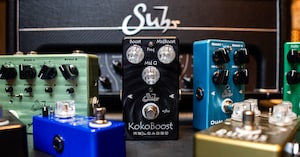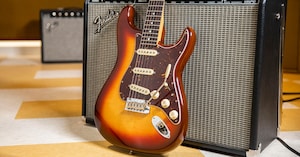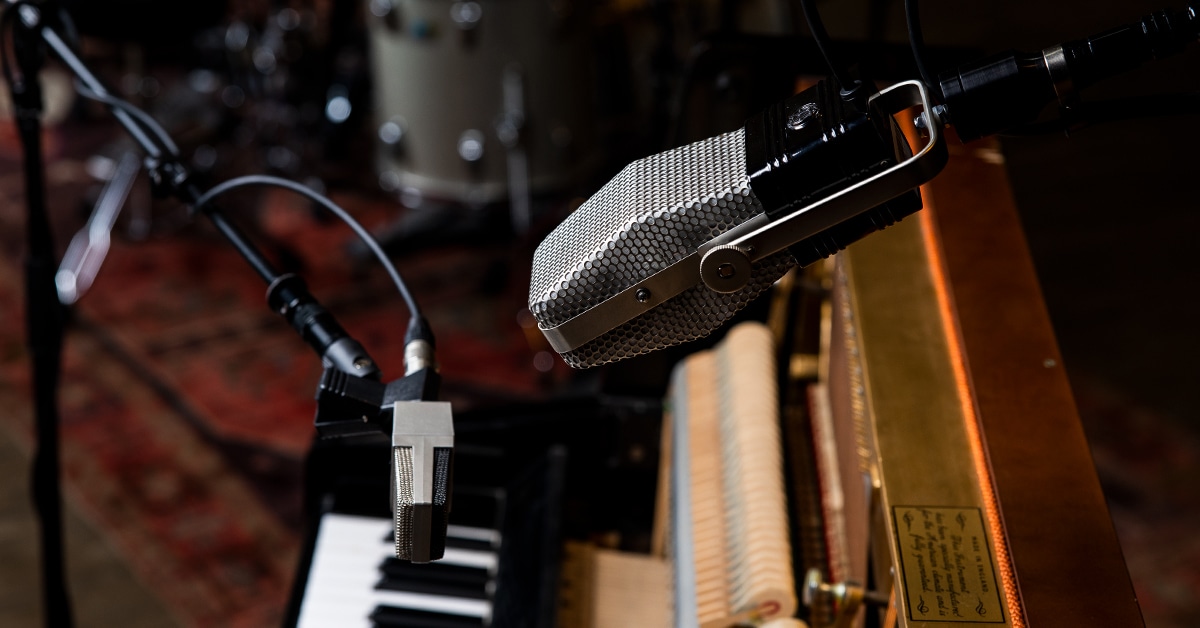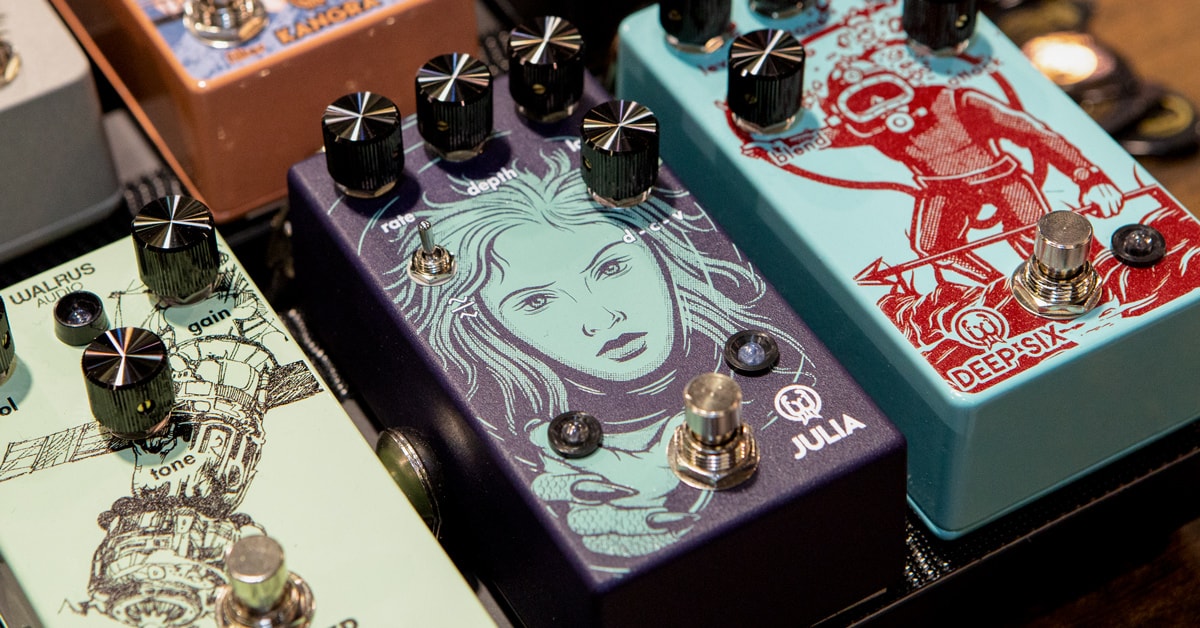If you’ve been playing guitar for a while, you’ve likely accumulated a number of guitar pedals by now. Maybe even a whole lot of them. In which case, a pedalboard that can help manage your signal chain, power distribution and playing ergonomics may be in your future.
Have you put off getting a pedalboard because designing its layout seems daunting? If so, you’ve come to the right place. With a little planning, your guitar effects pedalboard can be designed to work exactly the way you want. By considering a handful of factors, you can configure your stomp boxes and multi-effects processors to play nice with each other and perform consistently without noise or power issues.
In this guide, we’ll walk you through the process of designing a pedalboard layout that works with the way you perform and/or record. We’ll explore the various pedalboard designs, cables, power supplies, and the other pedalboard accessories you’ll find at Guitar Center.
To get started, you’ll need to round up the following gear:
- Your pedals and their specs
- Patch cables
- Power supply and power distribution gear
- Velcro or zip ties (for attaching pedals to your board)
Need help finding the best pedals for your pedalboard? Check out our Guitar Pedal Buying Guide.
Step 1: Finding the ideal pedalboard
To find a pedalboard that matches your current and future needs, take stock of the pedals you have today and those you plan to own in the next year or two. Be sure there’s space for everything.
In choosing your pedalboard, you’ll want to consider the following:
- How your pedals will be mounted (Velcro, cable ties, etc.)
- Audio and power cable routing
- Are adapter cables needed?
- Optimal pedalboard angle
- Travel bags/cases and accessories you may need
- How rugged does your rig need to be? Will you use it on the road or strictly in the studio?
Pedalboards come in a range of sizes, materials and designs. Most designs fall into three general size categories: small, medium and large. If you don’t plan to use more than five effects pedals, a small board should do the trick. A medium-sized board will typically be the right choice if you use between five and 10 effects. For larger pedal collections and those that include large-format multi-effects processors, a large board is needed.

Pictured: Pedaltrain Classic JR. Pedalboard with Tour Case
Many designs fall into one of two categories: those with Velcro-covered, flat pedal surfaces and those that use an open chassis with rails that permit cables to be routed below the pedal mounts. Rail-type pedalboards are usually constructed of lightweight metal alloy.

Pictured: Gator GPT-PRO Pedal Tote Pro Pedalboard
If your pedal count is small and so is your budget, give the On-Stage GPB2000 Compact Pedalboard a look. The angled aluminum frame is 18.75” x 6”—enough room for five standard pedals. Six cutouts allow you to arrange effects and cabling the way you want. A sturdy gig bag is also included.
Temple Audio Designs takes a different mounting approach with its pedalboards. They use quick release plates that mount onto the perforated board. They also have modular side panels for signal routing and power. The company’s DUO 24 Templeboard is a very affordable and popular choice. The modular approach of the Temple Audio boards is especially great for guitarists who have a lot of pedals and like to swap them around for the needs of different gigs.
You’ll also find pedalboards that come with pre-installed power supplies as well as those that require external power sources. We’ll get into the advantages of powered versus unpowered pedalboards in Step 2.
For outstanding flexibility, plug and play performance, and totally pro specs, the Voodoo Lab Dingbat Medium Pedalboard Power Package is hard to beat. Built in the U.S. from T6 aircraft-grade aluminum, it has a pre-mounted Voodoo Lab Pedal Power 2 Plus Power Supply with 8 isolated outputs that can handle 18V and 24V effects using included Voltage Doubler cables. An additional Pedal Power 2 Plus can be mounted below the pedalboard, and a rugged tour-grade gig bag is included.
Step 2: Figuring out your power needs
Many pedals require 9V DC power with negative polarity, but some effects need 12, 16, 18, or even 24V of DC power. A few even use AC power. Be sure to check the specs for each of your pedals to ensure your pedalboard or power supply will deliver what’s needed. You’ll often find the specs on the bottom of the effects pedal. Specs should also be in the manual.
The majority of pedals have 2.1mm barrel connectors while a few have 3.5mm connectors. Some older guitar pedals only connect to a 9V battery; however, adapter cables are available to deal with them.
Each patch cord connector has a positive and negative connection on it. On barrel connectors, there is a center (tip) and a barrel (ring). The polarity of the connector is determined by where those connections are made. Center-negative connectors are the most common. Occasionally you’ll see center-positive connectors, in which case you’ll need a reverse-polarity connector. A symbol, usually near the power connection, indicates the correct polarity.
The current draw of each pedal is expressed in milliamps (mA) and that spec often appears on the bottom of the case. Current draw can range from as little as 20mA to 1000mA. The key is to avoid under-powering as it may cause erratic performance or even damage the pedal. On the other hand, sending too many milliamps to a pedal is not an issue. Your pedal will only draw the current it needs. To figure out the total power you need, add up the total draw of all pedals then add plenty of headroom.
There are two approaches to powering multiple pedals. The simplest, most budget-friendly solution involves using daisy-chained patch cords that power each pedal from a single, non-isolated power source.

Pictured: Truetone 1 SPOT Combo Pack
If your signal chain includes effects with significantly different power needs for each pedal, an isolated power supply will likely be needed instead. These devices have isolated power outputs so that each outlet has its own power and ground. This means each pedal receives exactly its rated power rather than being downline of other effects that may generate noise that is amplified as it passes through the signal chain. Some daisy-chained effects may also operate inconsistently as other effects are activated or deactivated.
When a clean, low-noise signal chain is critical, professionals turn to the Voodoo Lab Pedal Power X4 Isolated Power Supply. It’s small enough to mount on the most compact pedalboards, including the Voodoo Lab Dingbat TINY and Pedaltrain Nano. Using the included AC adapter, it delivers up to 1000mA. The X4 also powers from any 12V 400mA Pedal Power output, supplying up to 400mA of current.

Pictured: Walrus Audio Aetos 120V Clean Power Supply
Of course, if space is a big consideration, check out the MXR M239 Mini Iso-Brick Isolated Power Supply. It takes up less space than a candy bar yet delivers clean, noise-free sound via four outputs, one of which can be switched to 18V operation.
Step 3: Consider Your Layout and Pedal Order
There’s been volumes written about the order in which to connect pedals on a pedalboard. In reality, though, there is no one correct way. Generally speaking, you’ll want to tune up using an unaffected signal, so your tuner usually is first in the signal chain. Also, generally speaking, time-based effects such as delays, reverbs and loopers will be connected at the end of the chain as they can otherwise muddy your sound.
Here’s a typical guitarist’s pedal signal chain:
Tuner --> Wah Wah (and/or Volume) --> Drive/Distortion/etc. -->Modulation --> Delay --> Reverb
Once you’ve tentatively laid your pedals out in order, your cable and connector needs will become more obvious. There are a variety of different sizes and shapes for patch cables, including some kits that allow you to easily make your own custom-length cables. You also need to consider whether to use straight or angled connectors—a decision largely determined by the layout you come up with. Keep in mind that the longer the cables, the greater their electrical capacitance, which can lead to noise and a loss of high-end response.

Pictured: George L's Effects Pedal Cable Kit
Flat patch cables can be easier to route since they take up less room. Ernie Ball Flat Ribbon Patch Cables are one of our top-sellers, and thanks to excellent shielding, they’re also very quiet.
Step 4: Start laying out your pedals
Don’t commit to anything just yet, but start laying out your pedals on your board and start hooking up your power and audio cables. When making your connections, do your best to isolate the power cables from your audio cables. For best audio performance, don’t run them parallel to each other. Ungrounded TS cables can pick up noise, so layout and routing are of utmost importance to ensure the cleanest signal possible.
After you make your connections, bring each pedal into your chain, adding one on top of the other. Listen for any noise issues that may have been introduced with each new pedal. If you detect unacceptable levels of noise, you’ll need to dig in and check each pedal and cable in the group and individually in order to identify the culprit(s).
If you’re really having trouble isolating the issue, try powering any offending pedals using batteries and disconnect any pedal power hookups. This will let you know if there’s a local cable issue. If the noise persists, consider swapping out your audio patch cables.
Step 5: Finalizing your pedalboard
Once you’ve sorted out any noise issues and fully optimized the order of your pedals, you’re ready to commit. Fasten your pedals to the board using Velcro or cable-ties and start kicking out the jams!
Shopping for Pedalboards
Setting up a pedalboard can be confusing. Don’t be afraid to ask our Call Center or store associates for help. Even if you’ve spent lots of time researching, you’re not going to have all of the answers that experience can provide. Our associates can help answer your questions and explain key features and functions.
Getting the Best Deal on Your Pedalboard Gear
Be sure to ask if there are any promotions or sales currently running. Regardless, our 45-Day Low Price Guarantee ensures your best deal. At the time of purchase or any time within 45 days of your purchase, if you find the identical product advertised by any authorized dealer—including Guitar Center—at a lower price than what you paid, just show us the ad and your original receipt, and we’ll refund you 100% of the difference.
Another way to save money on your new pedalboard gear is by selling us old musical gear. If you have a qualifying item you’d like to trade in, you can get 10% off your new setup, in addition to your trade credit.










